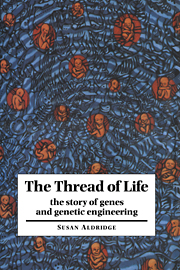2 - DNA in action
from PART I - What is DNA?
Published online by Cambridge University Press: 16 March 2010
Summary
DNA is a database. The information it contains allows the assembly of the all-important protein molecules within the living cell from their component parts, the amino acids. This database is passed on from one cell to another by the DNA molecule's power of self-replication, as we saw in Chapter 1. Now we look at how the protein recipes are extracted from DNA during the lifetime of an individual cell.
Information flow in most organisms is a one-way street: from DNA to protein. This rule is known as the Central Dogma of molecular biology. This term was coined by Francis Crick in 1956, many years before the details of the molecular processes involved were actually worked out.
The genetic code
The concept of the gene as an inheritable factor responsible for an organism's characteristics was first put forward by the Austrian botanist and monk Gregor Mendel in 1865. Mendel looked at how characteristics such as flower colour, height and seed shape were inherited during carefully controlled experiments with pea plants.
Peas are normally pure-breeding. They reproduce by self-pollination, in which pollen and ovules (the male and female sex cells) from the same plant unite, to give offspring that are similar to their parent. So a pea with white flowers would normally produce more peas with white flowers, and so on.
Mendel removed the stamens (which produce pollen) from his experimental plants, so they could no longer self-pollinate. Then he chose pairs with different characteristics: smooth or wrinkled seeds, red or white flowers, for example. He cross-pollinated these pairs by brushing pollen from one plant onto the stigma (the tip of the female sex organ) of the other.
- Type
- Chapter
- Information
- The Thread of LifeThe Story of Genes and Genetic Engineering, pp. 29 - 54Publisher: Cambridge University PressPrint publication year: 1996



